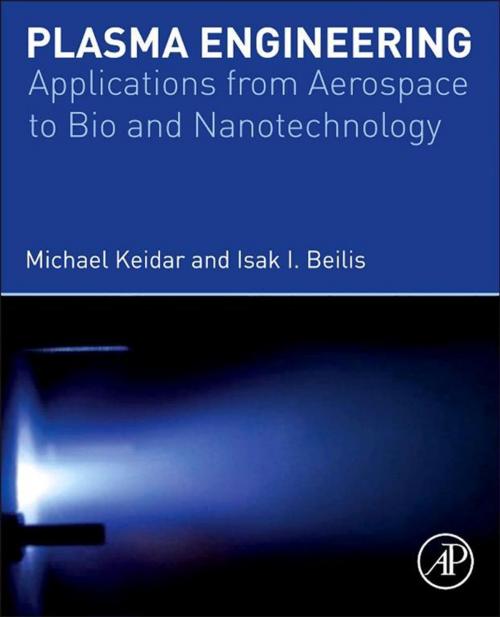Plasma Engineering
Applications from Aerospace to Bio and Nanotechnology
Nonfiction, Science & Nature, Science, Chemistry, Analytic, Physics, Optics| Author: | Isak Beilis, Michael Keidar, Ph.D., Tel Aviv University | ISBN: | 9780123859785 |
| Publisher: | Elsevier Science | Publication: | March 6, 2013 |
| Imprint: | Academic Press | Language: | English |
| Author: | Isak Beilis, Michael Keidar, Ph.D., Tel Aviv University |
| ISBN: | 9780123859785 |
| Publisher: | Elsevier Science |
| Publication: | March 6, 2013 |
| Imprint: | Academic Press |
| Language: | English |
Plasma Engineering is the first textbook that addresses plasma engineering in the aerospace, nanotechnology, and bioengineering fields from a unified standpoint. It covers the fundamentals of plasma physics at a level suitable for an upper level undergraduate or graduate student, and applies the unique properties of plasmas (ionized gases) to improve processes and performance over a wide variety of areas such as materials processing, spacecraft propulsion, and nanofabrication.
The book starts by reviewing plasma particle collisions, waves, and instabilities, and proceeds to diagnostic tools, such as planar, spherical, and emissive probes, and the electrostatic analyzer, interferometric technique, and plasma spectroscopy. The physics of different types of electrical discharges are considered, including the classical Townsend mechanism of gas electrical breakdown and the Paschen law. Basic approaches and theoretical methodologies for plasma modeling are described, based on the fluid description of plasma solving numerically magnetohydrodynamic (MHD) equations and the kinetic model particle techniques that take into account kinetic interactions among particles and electromagnetic fields. Readers are then introduced to the widest variety of applications in any text on the market, including space propulsion applications and application of low-temperature plasmas in nanoscience and nanotechnology. The latest original results on cold atmospheric plasma (CAP) applications in medicine are presented. The book includes a large number of worked examples, end of chapter exercises, and historical perspectives. There is also an accompanying plasma simulation software covering the Particle in Cell (PIC) approach, available at http://www.particleincell.com/blog/2011/particle-in-cell-example/.
This book is appropriate for grad level courses in Plasma Engineering/Plasma Physics in departments of Aerospace Engineering, Electrical Engineering, and Physics. It will also be useful as an introduction to plasma engineering and its applications for early career researchers and practicing engineers.
- The first textbook that addresses plasma engineering in the aerospace, nanotechnology, and bioengineering fields from a unified standpoint
- Includes a large number of worked examples, end of chapter exercises, and historical perspectives
- Accompanying plasma simulation software covering the Particle in Cell (PIC) approach, available at http://www.particleincell.com/blog/2011/particle-in-cell-example/
Plasma Engineering is the first textbook that addresses plasma engineering in the aerospace, nanotechnology, and bioengineering fields from a unified standpoint. It covers the fundamentals of plasma physics at a level suitable for an upper level undergraduate or graduate student, and applies the unique properties of plasmas (ionized gases) to improve processes and performance over a wide variety of areas such as materials processing, spacecraft propulsion, and nanofabrication.
The book starts by reviewing plasma particle collisions, waves, and instabilities, and proceeds to diagnostic tools, such as planar, spherical, and emissive probes, and the electrostatic analyzer, interferometric technique, and plasma spectroscopy. The physics of different types of electrical discharges are considered, including the classical Townsend mechanism of gas electrical breakdown and the Paschen law. Basic approaches and theoretical methodologies for plasma modeling are described, based on the fluid description of plasma solving numerically magnetohydrodynamic (MHD) equations and the kinetic model particle techniques that take into account kinetic interactions among particles and electromagnetic fields. Readers are then introduced to the widest variety of applications in any text on the market, including space propulsion applications and application of low-temperature plasmas in nanoscience and nanotechnology. The latest original results on cold atmospheric plasma (CAP) applications in medicine are presented. The book includes a large number of worked examples, end of chapter exercises, and historical perspectives. There is also an accompanying plasma simulation software covering the Particle in Cell (PIC) approach, available at http://www.particleincell.com/blog/2011/particle-in-cell-example/.
This book is appropriate for grad level courses in Plasma Engineering/Plasma Physics in departments of Aerospace Engineering, Electrical Engineering, and Physics. It will also be useful as an introduction to plasma engineering and its applications for early career researchers and practicing engineers.
- The first textbook that addresses plasma engineering in the aerospace, nanotechnology, and bioengineering fields from a unified standpoint
- Includes a large number of worked examples, end of chapter exercises, and historical perspectives
- Accompanying plasma simulation software covering the Particle in Cell (PIC) approach, available at http://www.particleincell.com/blog/2011/particle-in-cell-example/















